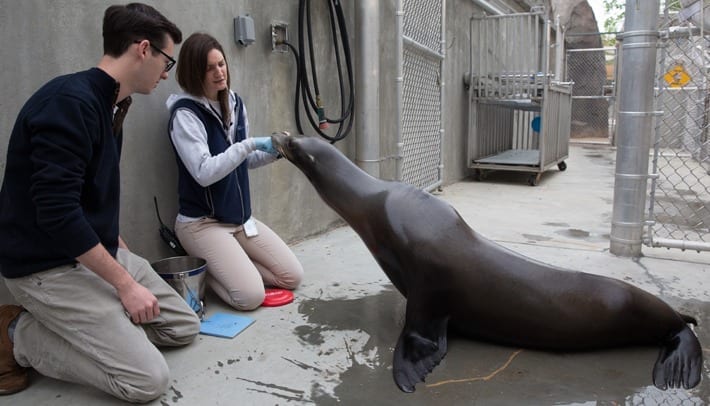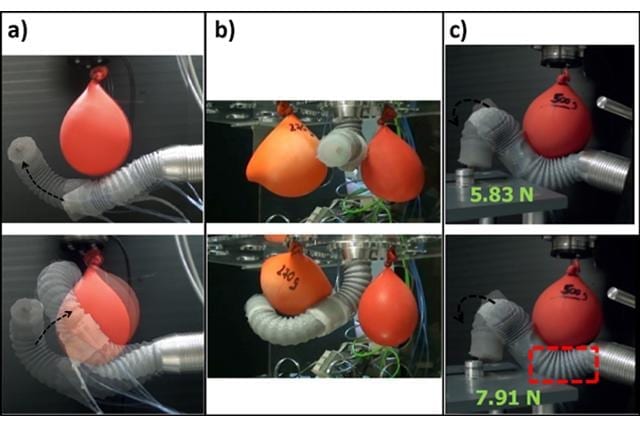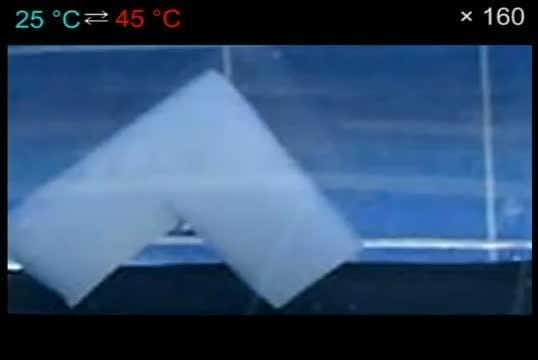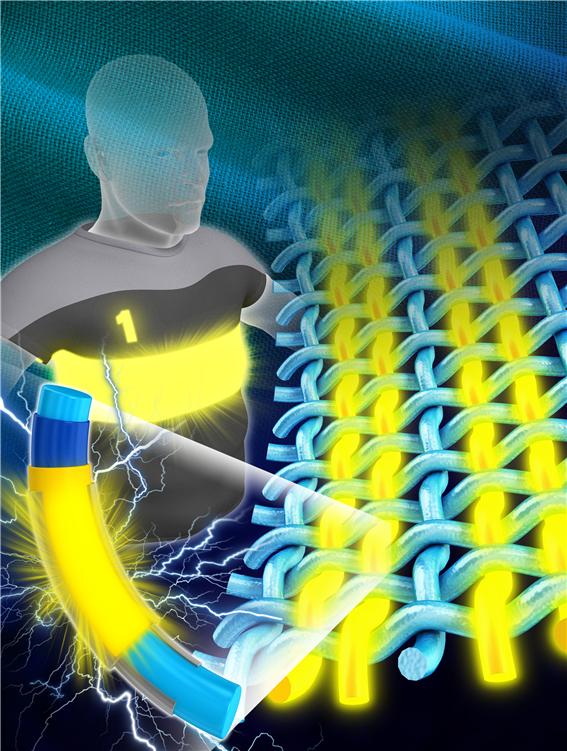
GW Professor Designs Robotic Foreflipper That Mimics Mammal’s Movement, Hoping it Will Aid Mechanical Innovation in Intelligence Community
At a maximum speed of 25 miles per hour, sea lions may not be the fastest-swimming mammal in the sea. But they are unrivaled when it comes to stealth—their signature clap-and-glide flipper motion propels them through water and leaves virtually no wake.
Megan Leftwich, a George Washington University professor of mechanical and aerospace engineering, took notice of this anomaly during a visit to the Smithsonian National Zoo with her children in 2013. While other mammals use their tails or additional fins to help them swim, leaving wakes, sea lions flip and spin without the added help, and without the wake. Dr. Leftwich wondered how they did it and, being an engineer, she speculated whether researchers could replicate the motion.
“Sea lions swim with their foreflippers, or front flippers, rather than their tail and their propulsive motion is barely detectable,” Dr. Leftwich said. “What we’re trying to do is apply this mechanism to man-made objects. Can we build an underwater vehicle that can go undetected?”
To answer this question, Dr. Leftwich and her team videotaped sea lions swimming at the Smithsonian’s National Zoo to capture the foreflipper’s movement frame by frame and track points on their “arms” to mathematically describe the flapping motion. They used the mathematical description to design a plastic robotic arm that mimics a sea lion’s shoulder, elbow and wrist joints.
Then, Dr. Leftwich 3-D scanned and printed a sea lion foreflipper to cover the “arm” with a silicone version of the skin to study the possible effect wrinkles and hairs have on the drag when swimming. These studies were conducted in GW’s Science and Engineering Hall using flow diagnostic techniques to chart the fluid’s movement and the forces it takes for a sea lion to move its foreflipper.
Dr. Leftwich chronicled her research in a paper published last month in the Journal of Aero Aqua Bio-mechanisms. Her next step is to bring the robotic foreflipper to SLEWTHS (Science, Learning and Education With The Help of Sea Lions), a teaching aquarium in California, to test her experiment directly with animals in their natural habitat.
“Observational studies like these are the first step in a research program that will lead to deep understanding of this unique swimming paradigm,” Dr. Leftwich said. “Now that we’ve done the preliminary studies at the National Zoo, we need to test the theories we’ve developed on foreflippers in a lab involving scientifically trained sea lions.”
Read more: Swimming Without a Trace—Building a Machine to Mimic What Sea Lions Naturally Do
The Latest on: Mechanical Innovation
[google_news title=”” keyword=”Mechanical Innovation” num_posts=”10″ blurb_length=”0″ show_thumb=”left”]
via Google News
The Latest on: Mchanical Innovation
- 3 notable wind turbine innovations to eke out every Watton April 27, 2024 at 9:05 pm
Wind turbines are a towering solution in the global transition toward renewable energy. Today's turbines have undergone significant evolution since the time when windmills generated mechanical power ...
- Innovation Meets Creativityon April 27, 2024 at 1:37 pm
Artificial intelligence, robots, glass blowing, virtual reality, and performing arts were just a sampling of what thousands of visitors experienced at the 2024 Imagine RIT: Creativity and Innovation ...
- SUPCON opens new innovation center and launches Navigator α humanoid roboton April 26, 2024 at 5:30 am
SUPCON has debuted its new humanoid robot for R&D and industrial use at the new Zhejiang Humanoid Robot Innovation Center.
- Ingenuity & innovationon April 25, 2024 at 5:11 pm
BTech students equipped with the right skills and knowledge can capitalise on emerging trends and seize the ever-expanding opportunities across various ...
- Intellectual Property Spurs Innovation Toward Sustainable Development on World IP Dayon April 25, 2024 at 5:00 pm
While technical innovation may be complex ... from transactional due diligence to litigation and patent prosecution. This encompasses mechanical, electrical, hardware, and software technology ...
- Satechi launches Slim Mechanical Keyboard, announces foldable Qi2 multi-device chargers [U]on April 25, 2024 at 9:34 am
Satechi is out with its first CES announcements today. The new SM1 Slim Mechanical Backlit Bluetooth Keyboard for Mac, ...
- Innovative peptide-based hydrogel therapy for virus preventionon April 24, 2024 at 9:43 am
Vaccines remain the gold standard of protection against dangerous pathogens, but take considerable time and vast resources to develop.
- IRC Announces Winner of Innovation Challenge to Improve Last Mile Medical Supply Deliveryon April 24, 2024 at 7:50 am
The IRC has named Samuel Kamunyu Karuru of Ghana and Reginah Onyango of Rwanda as the winners of the Wazoku crowdsourcing challenge to improve the last mile delivery of essential medical supplies. ...
- Embark on Innovation: Jasionbike Launches X-Hunter for the Ultimate Explorationon April 23, 2024 at 1:36 am
Jasionbike Launches X-Hunter for the Ultimate Exploration.United States - April 23, 2024 — In the lush greenery of the ...
- Mechanical devices installed to combat floodingon April 22, 2024 at 5:30 pm
Speaking on the significance of the initiative, a spokesperson from the BBMP SWD department highlighted the critical role of collaborative partnerships in driving sustainable urban development. They ...
via Bing News










